How to Cold-Smoke Salmon at Home | Step-by-Step Tutorial
Follow this easy, step-by-step process to make delicious cold-smoked salmon at home. It is better than store-bought!
My husband has perfected the method and recipe for cold-smoked salmon. We are very lucky that he not only catches the salmon off the Northern California coast by himself but also smokes it at home.
Whether you are serving it for breakfast, as an appetizer, or any other time, you will love the taste and texture!
This post contains affiliate links, which means I make a small commission at no extra cost to you. You can read my full disclosure.
What salmon can you smoke?
Most all salmon and steelhead, wild or farmed, will make good smoked fish. However, King salmon (aka chinook), Atlantic salmon, or Steelhead are particularly good because of their size and oil content.
Most importantly, though, regardless of the salmon species you are using, it needs to be appropriately frozen beforehand to kill parasites that can occur in freshwater fish such as salmon/steelhead.
Freezing does not diminish the quality of the fish for smoking as the normally negative effect of dehydration from freezing is not a problem for smoked fish.
See FDA health safety guidelines regarding preparing raw fish for consumption: https://www.fda.gov/media/80777/download
Hot smoking versus cold smoking
Cold smoked salmon is cured with salt and smoke and not cooked. Therefore, it is raw but salting and smoking act to preserve it. You can eat this type of smoked salmon just like lox; we like to eat it on bagels or crackers. Lox and Gravlax is raw salmon that is cured with salt but usually not smoked. Hot smoking salmon actually cooks it during the smoking process.
If you are not particularly sodium-sensitive, it is a great superfood filled with healthy omega-3 oils and vitamins along with a protein level similar to ground beef.
Ingredients for cold-smoked salmon
Obviously, you need a piece of previously frozen salmon.
Then you need some salt and sugar. You can leave out the latter, however, we find it gives the smoked salmon a better taste.
We prefer either regular sea salt or kosher salt. We do not use curing salt as it contains other additives such as nitrates which we like to avoid. And we do not use table salt because of the iodine content.
As for sugar, we like to use light brown sugar.
Supplies for cold-smoked salmon
In order to create the smoke, you need sawdust. My husband has meticulously tested various woods and sources. Since ready-made sawdust can be expensive and/or hard to come by, he prefers to make the sawdust himself. His favorite wood is alder but all fruitwoods work well too. We will show you a simple and inexpensive way to create your own sawdust.
1 lb of sawdust will burn for over 24 hours.
Then you need a smoke chamber. We like to use an old Big Chief Smoker for our smoke chamber only because we already had it and it has racks to hold the fish. We don’t use the hot smoke heated element feature on it but instead use a cold smoke generator with sawdust. It does perform well as a hot smoker so it can do double duty if you like.
In order to jumpstart the smoke generator, we use a little lighter fluid but a propane torch will also work fine.
Alternatively, for a smoke chamber, you can use a barbeque or large cardboard or wooden box. This is great if you want to try this recipe out before committing to buying equipment.
Thoughts about curing the salmon before smoking:
Salting meats such as fish helps preserve the meat to give it a longer shelf life without freezing. The more you salt and dehydrate the fish, the longer you can keep the fish in the refrigerator. Lox or Gravlax is essentially raw salmon with a lot of salt (but not smoked). You can easily refrigerate it for 6 weeks or more (https://medcraveonline.com/JAMB/effect-of-fillet-thickness-on-quality-and-shelf-life-of-gravlax-salmon.html). In our recipe, we use less salt and curing because that is how we like it. Also, we usually eat it within a week so shelf life is not a concern for us.
Our curing recipe is 12% by weight of salt and 12% by weight of brown sugar. For convenience, we vacuum seal the salt and sugar in a bag with the salmon and let it brine for 48 hours. Alternatively, one can cure the fish in a non-reactive pan such as glass or plastic. The size of the pan should be close to the size of the piece of fish so that it remains in contact with the brine wall sitting. You can simply pile the salt and sugar on top of the fish in the pan and let it sit n the refrigerator for 48 hours.
We have also found that freezing the smoked salmon does not affect its taste or texture much. As will all food preparation, it is important to use sanitary methods during preparation and storage, especially for uncooked meats.
Thoughts about smoking the cured salmon:
The key to cold smoked salmon is to expose the cured salmon meat to smoke that will not cook the fish. Fish will begin to cook at about 120 degrees. Therefore, we use a smoke source that does not produce much heat, such as a smoldering line of sawdust. You can easily accomplish this with a smoke generator.
You can place this inside your smoke box since it produces very little heat. The smokebox can be any compartment in which the smoke or air can enter, accumulate, smoke the meat, and then exit. The airflow keeps the sawdust embers lit. A slightly open barbecue grill or even a cardboard box works well, too.
Within the smoke chamber, the cured salmon needs to either hang or sit on wire grates so that smoke can surround the meat.
Smoking will also act to preserve the meat further by dehydration and lowering the pH at the meat’s surface. We smoke our salmon from 6 to 24 hours but typically only 12 hours or so. Filling our smoke generator 1/2 way achieves this. If you are starting out, we recommend lighting only one end of the smoke generator. Later, you might like to light it at the center and the end, as we sometimes do, for a shorter but more intense smoke.
Smoking and flavor:
Cured salmon will taste good at almost any amount of smoking. Smoking will dry the meat and impart a smoky flavor to it. So if you wish to have a heavier sausage-like flavor you can smoke longer and if you prefer a lox-like texture you can smoke for short period.
How to make cold-smoked salmon:
- Wash the salmon: This helps flush out any bacteria that might have accumulated. We also rinse the bag as we use it for curing.
- Salt the salmon: Weigh your piece of salmon. Calculate 12% of that weight. This is the amount of salt and sugar you will need. Weigh it out. Place the salmon in the washed bag, add the salt first, then the sugar. Knead the salmon in the bag for a bit to mix things up.
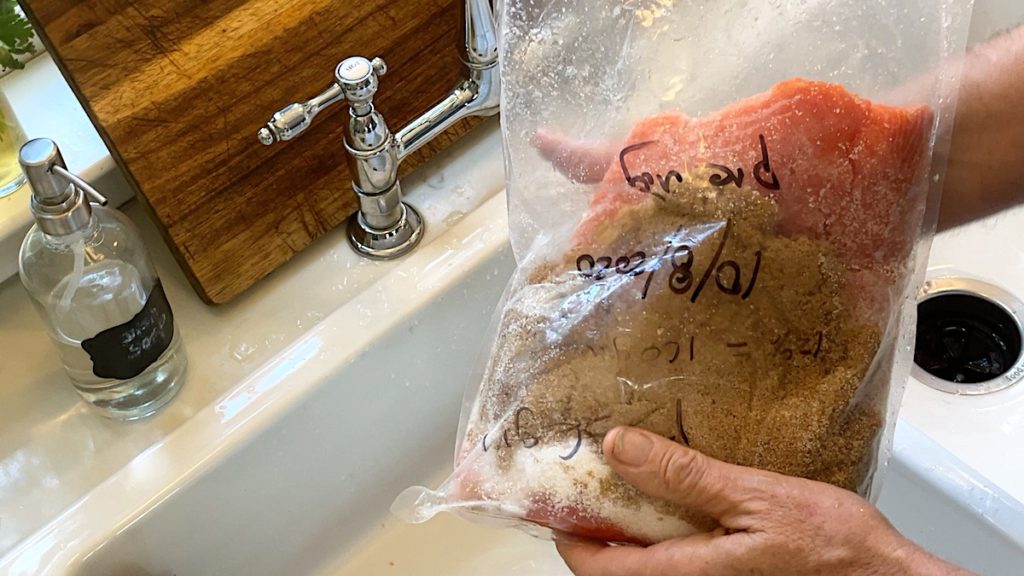
- Vacuum-seal the bag (optional): We like to vacuum-seal the salmon in the bag. You can always simply place the salmon in a glass dish and put the salt and sugar on top.
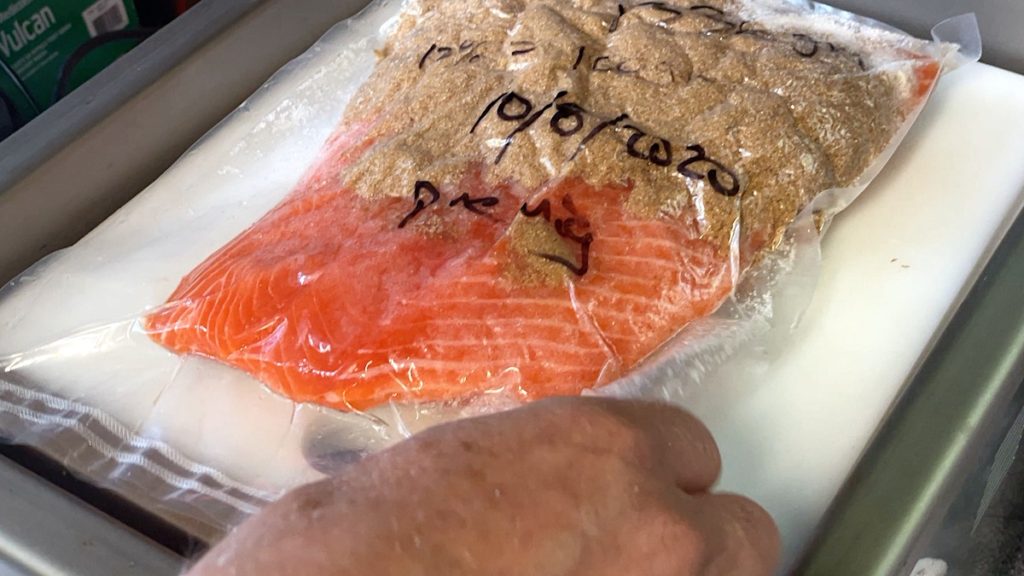
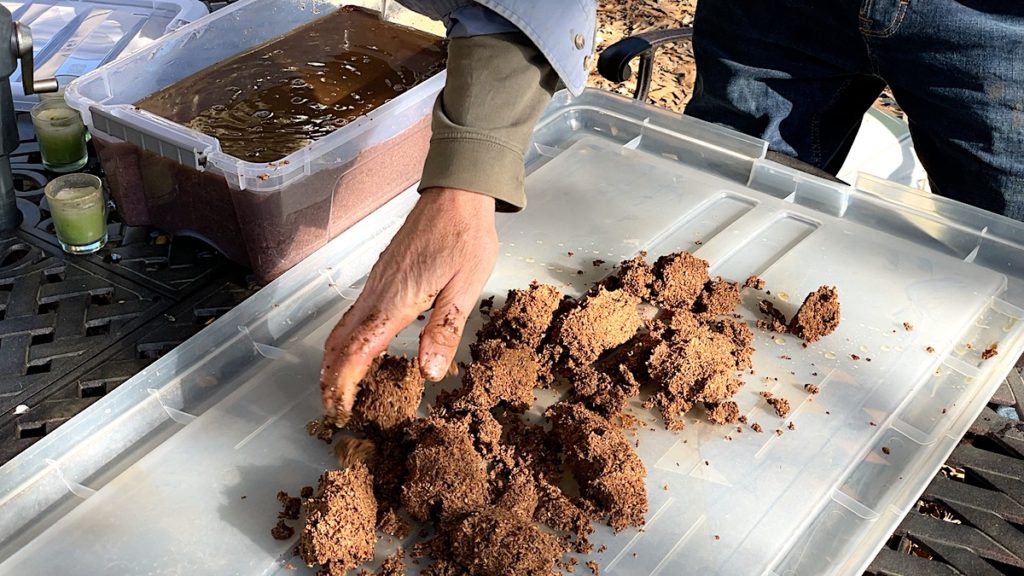
- Cure the salmon: Place the salmon in the refrigerator and cure it for 48 hours.
- Make the sawdust: Place the wood pellets in a large bin or bucket. Add enough water to soak the pellets. Let this sit for a few hours or more. Mash the pellets and squeeze excess water out of the wood “mush” and place it on some tray to dry it in the sun. Stir it occasionally to dry it thoroughly. This can take a few days, depending on the temperature and how much sun it gets.
- Fill the smoke generator: Place the sawdust in the smoke generator. Make sure to have the metal rings exposed so that the embers don’t jump over.
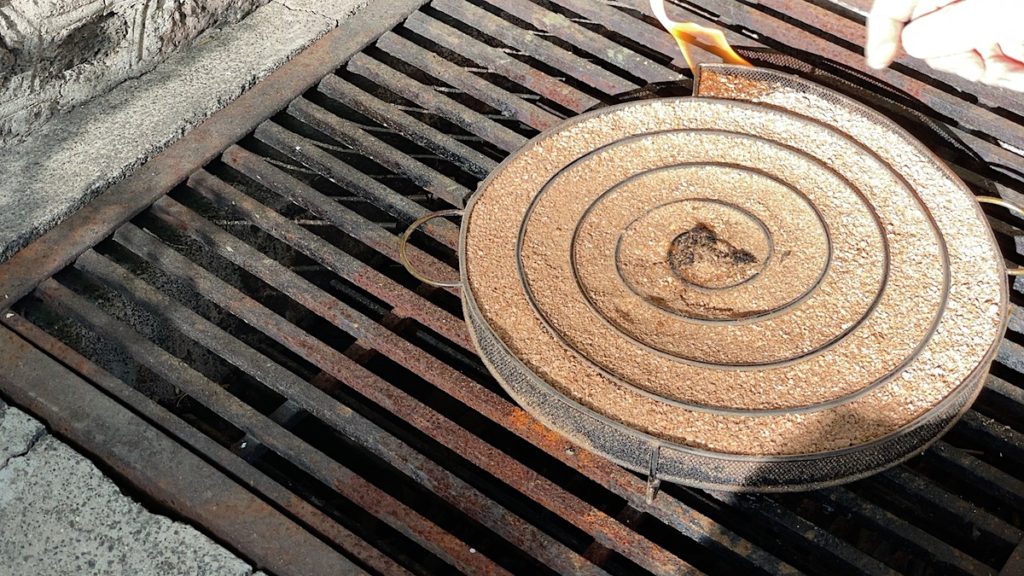
- Prepare the salmon: Take the salmon out of the vacuum bag or dish and rinse underwater. Most likely, it will have lost 12% or so of its weight. Place it on the rack for the smoke chamber.
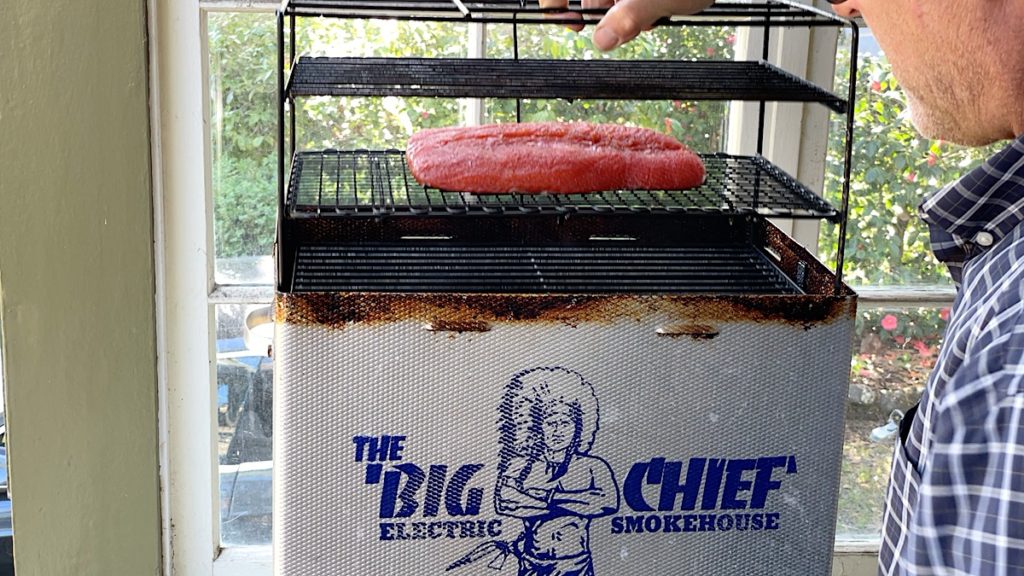
- Smoke the salmon: Light the smoke generator at one end or also in the center. We like to jumpstart it with lighter fluid. Place it in the bottom of the smoke chamber. Add the salmon and close the smoke chamber. Keep it in a cool place, ideally below 60˚F. Check every so often that the smoke is still going. You can leave it in there from 3 to 48 hours or more. It will be good regardless. We typically smoke for about 12 hours.
- Enjoy!
Tips and tricks:
• Again, you can buy sawdust or make your own from wood pellets. The latter is very economical. Depending on how much you pay for the wood pellets, it costs less than $1 to smoke a piece of salmon.
• We prefer to make a lot of sawdust during the warm weather months. Then we store the sawdust in airtight bins and use it as we like to smoke our salmon during the cooler months of the year.
• You can cold-smoke your salmon and freeze it. We didn’t notice any difference in taste or texture.
• We like to cut off the darker parts of the salmon. They taste fine but just don’t look as appealing.
• Make sure you have a good, sharp knife to cut your smoked salmon into very thin slices.
• Fishbones make good bone broth. Here’s a tutorial on how to make your own.
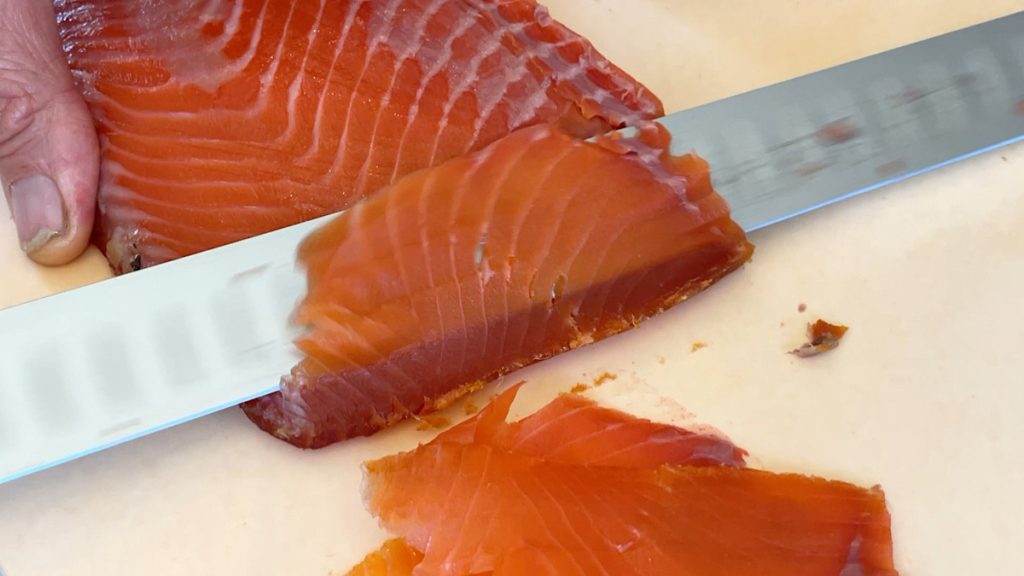
Shop this post:
Sea salt: https://amzn.to/2OGzf74
Kosher salt: https://amzn.to/2PPi587
Brown sugar: https://amzn.to/2OGz1gg
Vacuum sealer: https://amzn.to/3uJz0rb
Smoke generator: https://amzn.to/3g21NmU
Lighter fluid: https://amzn.to/3s8q7pr
Big Chief Smoker: https://amzn.to/2RvalZj
Applewood pellets: https://amzn.to/3wR1gtV
Let me know if you have any questions or comments!
Pin For Later:
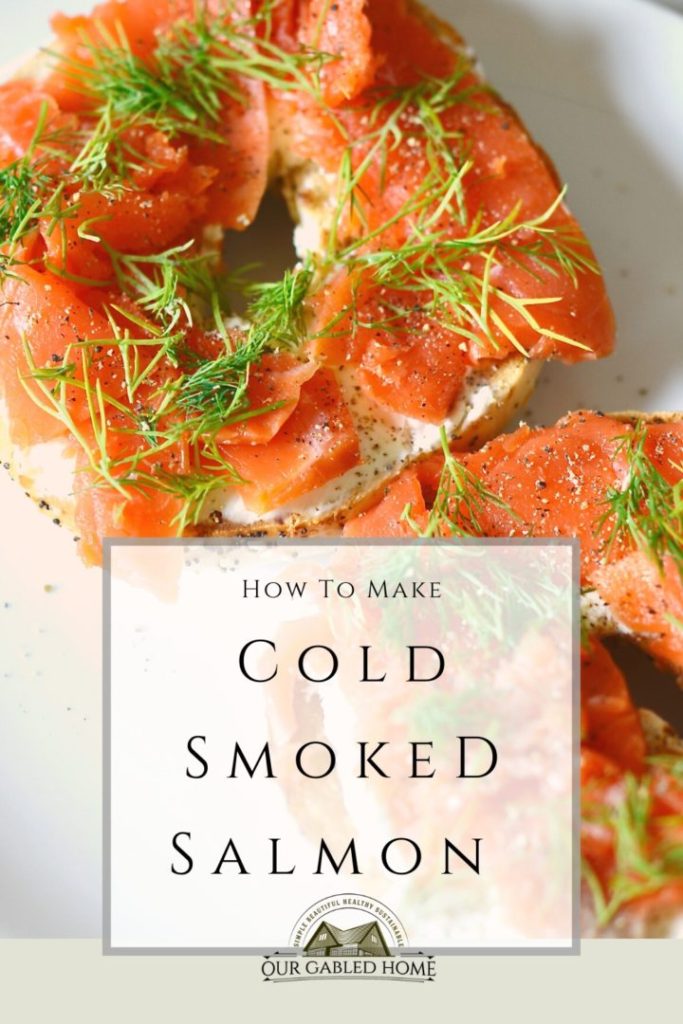


Thanks for instructions that I can use without having an actual smoker. What size smoke tray do you use for the 12 hour smoke? The link has an 8″ and 13″. Does the size of the fish change how long to smoke?
I think ours is an 8″ and theoretically, the size of fish will determine how long to smoke. My husband doesn’t change the time and our smoked salmon is always delicious ~ Anja
Anja, this looks amazing! I have wanted to try this for such a long time! Now I have to:)
That’s great! It’s actually not complicated! Have fun making it ~ Anja
This is so interesting! We have gotten into smoking some meats, but not fish. This sounds good.
Then you’re already halfway there 😉
This is a project I need to take on! I love smoked salmon. I usually don’t buy it because it’s a little pricey. Great info and tips here! Thanks!
I am so glad you enjoyed this tutorial! Let me know how it turns out when you decide to make it!